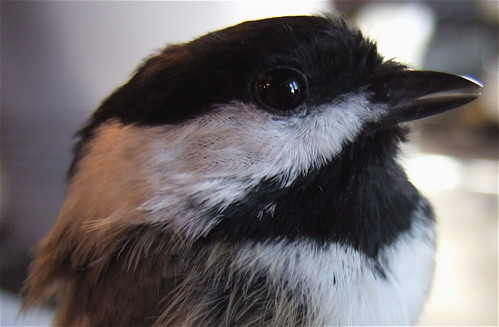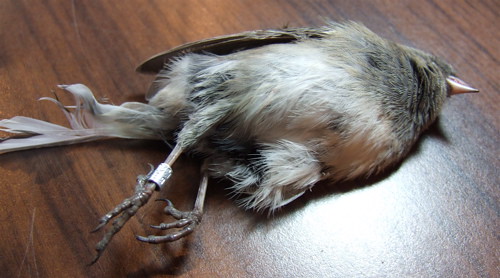And yet another grasshopper sparrow, they are everywhere I go, I can't escape them. I've seen them before, but not like this summer. I don't know if I'm just paying more attention or if we are having a bumper crop of grasshopper sparrows...or if aliens from some distant planet are trying to send me a message about saving the planet via grasshopper sparrow (although, that would seem to me to be an unreliable messenger).
You can tell this press release about Cape May Bird Observatory's new website was sent by a hardcore birder:
"Since you all have blogs and/or have close connections to Cape May I thought you might like to take a look at the site..... and in the event that you might be looking for something to write about given the slow nature of the summer......."
Slow nature of summer? Not in my neck of the woods! There's always some birding happening (and now bees--and some new caterpillar madness had started which I'll be talking about soon). Oh, how my grasshoppery ways have caught up to me this last week--sheesh. Here it is Monday, and I have bloggin' left over from last Friday.
 So, Friday at Carpenter was a first for me--banding a tiny bird. Usually, at Carpenter, I'm happy to lurk and watch the pros but the bands swiftly on the birds. I enjoy trying to get the birds out of the net and bringing them in, but I always felt my place at the table was to just promote all the cool things that they do. I'm used to banding large birds, but not the tiny ones, so I have avoided actually pacing a band on a bird. Friday that changed. There have been offers before, but every time I always answer, "Oh, let's wait for a cowbird, let me practice on a cowbird, not a chickadee or goldfinch."
So, Friday at Carpenter was a first for me--banding a tiny bird. Usually, at Carpenter, I'm happy to lurk and watch the pros but the bands swiftly on the birds. I enjoy trying to get the birds out of the net and bringing them in, but I always felt my place at the table was to just promote all the cool things that they do. I'm used to banding large birds, but not the tiny ones, so I have avoided actually pacing a band on a bird. Friday that changed. There have been offers before, but every time I always answer, "Oh, let's wait for a cowbird, let me practice on a cowbird, not a chickadee or goldfinch."
Friday, Jen Veith, the Development Director and experienced bander would not take no for an answer and had me band my first tiny bird--a house wren--man oh man, talk about a really tiny bird to band! Larry took a photo of this momentous occasion (above photo). It all happened so fast, and I was so freaked about not breaking one of those tiny wings, or legs that I barely remember it.
 Up next was a house finch. Larry helped supervise the banding of that bird. You will note that we are doing these outside. Jen recommended that the first few times I band birds outside, that way, if I accidentally let one go, it won't risk injury by hitting walls and windows indoors. I was much more comfortable putting the band on this one.
Up next was a house finch. Larry helped supervise the banding of that bird. You will note that we are doing these outside. Jen recommended that the first few times I band birds outside, that way, if I accidentally let one go, it won't risk injury by hitting walls and windows indoors. I was much more comfortable putting the band on this one.
 Here I am taking the wing cord--fancy talk for measuring the wing. This house finch was a hatch year bird (hatched this year) and we couldn't tell if it was male or female. I measured the wings, all went well and the bird flew away.
Here I am taking the wing cord--fancy talk for measuring the wing. This house finch was a hatch year bird (hatched this year) and we couldn't tell if it was male or female. I measured the wings, all went well and the bird flew away.
 Since many of the birds I have banded (pelicans, hawks) it's still hard for me to get the songbird bander's grip down: holding the bird in my left hand with it's back to my palm, it's head between my index and middle fingers, also holding it's chest. With my small hands, the finch and wren fit easily in my hand...
Since many of the birds I have banded (pelicans, hawks) it's still hard for me to get the songbird bander's grip down: holding the bird in my left hand with it's back to my palm, it's head between my index and middle fingers, also holding it's chest. With my small hands, the finch and wren fit easily in my hand...
Then came a much larger hairy woodpecker--not so easy to hold in one hand--good grief, how will I ever hold a blue jay in one hand? This bird we could tell was female and were able to determine her age by her eye color (brown to grayish brown indicates that this bird was hatched either last year or this year). She also had a brood patch for incubating eggs and chicks, which she wouldn't have if she hatched this year, so that means she is a second year bird--she was hatched last year.
 In between teaching me how to band, Larry got to band an eastern phoebe. I took a picture with his new Sony digital camera--it's got a pretty good macro feature--look at that feather detail. While we were taking this photo, the phoebe flapped a few times, and each time we heard a rapid clicking noise--phoebe's snap their bill when agitated--just like owls do! I never knew they did that. Of course, I've never had the opportunity to make a phoebe angry.
In between teaching me how to band, Larry got to band an eastern phoebe. I took a picture with his new Sony digital camera--it's got a pretty good macro feature--look at that feather detail. While we were taking this photo, the phoebe flapped a few times, and each time we heard a rapid clicking noise--phoebe's snap their bill when agitated--just like owls do! I never knew they did that. Of course, I've never had the opportunity to make a phoebe angry.
After banding, Jen and I explored the prairie area at Carpenter--loaded with grasshopper sparrows (another one above) and sedge wrens. Jen and I came upon a family of grasshopper sparrows, and the young were just learning to fly. It was a hoot to watch their labored flights around us and then the oh so awkward landing on what looked like a sturdy perch but turned out to be a wobbly prairie flower. About as graceful as a girl in her first pair of high heels.
There was also a pair of eastern meadowlarks scolding us, we must have been too close to their nests. It would be fun sometime to move the banding operation out to the prairie and get some bands on the birds out here.















